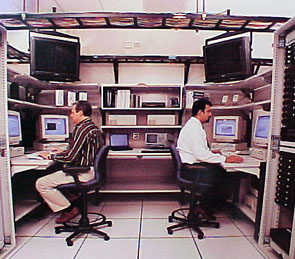BICSI Winter 2000: Anixter Testing Reveals Significant Variance in Cabling
Even as the cabling standards continue to coalesce, the common at BICSI consensus is that more testing is needed for cabling—and for components.
A common theme at the <%=company%> Winter Conference, held this week at Disney's Coronado Springs Resort in Orlando, FL, was a concern that perhaps cabling systems are promising too much. Even as the standards continue to coalesce, the common consensus is that more testing is needed, and it must be channel-wide.
Anixter International Inc. (Skokie, IL) reports that advanced procedures in its Anixter Levels Lab (ALL), product-testing laboratory verify its concern that many cabling systems are operating inefficiently, even if the individual components comply with industry standards. The company says measurable errors—as many as 2,609 in less than an hour in one study—are resulting in lost or corrupted data, slower network response time and decreased productivity.

"As we got into Gigabit Ethernet on Category 5 cabling, we had four channels on at a time," said Pete Lockhart, Anixter's vice president of technology, at the BICSI convention. "We had to look at different ways of measuring and quantifying with actual network data. The industry has been conducting static, megahertz-based testing of the electrical attributes of cable, but at we can now conduct live, or active, megabits-based testing of data transmission from one end of a cabling system to another. Testing megabits means testing data."
The existing industry standards for characterizing cabling fall short by setting forth only the minimum performance requirements. Anixter established specifications in 1989 for rating the cable it purchases from manufacturers, but it was six years before the TIA/EIA used Anixter's specifications as the model to create and ratify the current industry category rating system—i.e. Category 3, Category 5, and the draft Category 5e and Category 6 specifications.
The industry is now considering Category 5e with more stringent requirements for cabling. In 1997, Anixter introduced Levels 5, 6, and 7 for rating cable, all of which meet or exceed the proposed Cat 5e. The following year, Anixter introduced its specifications for rating the entire channel, from PC to the hub, called the Anixter Levels Channel (ALC 5, 6, and 7).
Testing results
Anixter has conducted extensive testing on how cabling interacts with network interface cards (NIC), hubs, and switches. In one active study released at the BICSI conference, Anixter used a cabling system labeled and sold as Cat 5e compliant with hubs and NIC cards that compiled with IEEE specifications. Running on 100Base-T, the ALL noted 2,609 errors within 56 minutes.
"We conducted the same test using a cabling system that met our ALC 6 specifications and then our ALC 7 specs," said Lockhart. "With ALC 6, there were only seven errors in 56 minutes. With ALC 7, we experienced no errors, no retransmissions and no dropped or corrupted data, We had 100 percent throughput. Even with the variations and marginal performance of the transmitter and receiver electronics, the ALC systems' extra bandwidth held the data signals nearly error-free while the channel labeled as Cat 5e was getting hammered."
Lockhart pointed out that eliminating errors not only increases productivity and reduces maintenance costs, but also reduces the frustration and bottlenecks caused by retransmissions.
"Ethernet is not a perfect medium. It is a collision domain," said Lockhart. "If you try to do things where there is data holes or retransmissions, it really slows down the channel. The main thing we learned is just because the green light is on, it doesn't mean you are getting good data. All the green light says is that you have link. Electrons are moving from one point to another.
"Electrical performance can be different between products or even ports, and the difference can be staggering."
Anixter plans to share information
Anixter's director of marketing, Frank LaPlante, said that the results of further testing would be published in white papers and lab reports to educate contractors and end-users on the importance of using the appropriate cabling systems. He noted that the demands of advanced applications such as Fast Ethernet, CDDI, ATM and Gigabit Ethernet require better methods of determining if cabling systems can reliably transfer information.
"For customers planning new installations, we won't recommend Cat 5e or even our own level 5 cabling if they are planning to use Fast Ethernet or greater," said LaPlante. "Cabling solutions that we have rated ALC 6 should be the minimum."
LaPlante said Anixter plans to fill a void by taking on the role of educating the industry on variances that can be found in cable and in the many active and passive components that must work together for maximum data transfer.
"The rapid advances in high-speed access technology demand that the pipelines for information keep up, but the committees that establish cabling standards have been slow and cumbersome because they meet infrequently," LaPlante explained. "The newest method of defining network efficiency probably won't result in industry standards for at least three years. Consequently, we feel an obligation to continually educate companies so that they can make informed decisions."
Anixter International is a global distributor of wiring systems and networking products that sells more than 54,000 items, including copper and fiber-optic transmission cable and electrical wiring systems for computer- and electricity-related applications. Its primary market is North America, which accounts for more than 70% of sales.
